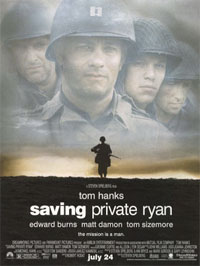Saving Private Ryan

Boot Camp
To transform their acting ensemble into a credible military unit, the filmmakers enlisted the aid of former U.S. Marine Corps Captain Dale Dye, whose dedication to the military did not end with his retirement from the service.
"I believe there is a certain core spirit that is common among men and women who fight for their country, and I think to understand it fully, the actors playing them need to experience the rigors that combat people all over the world face," Dye states. "So, to the extent I can, I immerse the actors in that lifestyle: I take them to the field; I make them eat rations; I make them crawl and sleep in the mud and the cold and the dirt... And when they come out, if I've done my job successfully, they have an inkling of what people sacrifice to serve their country in the military."
Dye and the staff from his company, Warriors Inc., took Tom Hanks, Tom Sizemore, Edward Burns, Jeremy Davies, Vin Diesel, Barry Pepper, Giovanni Ribisi and Adam Goldberg through what amounted to nothing less than boot camp. From the start, he kept them constantly reminded of the job at hand, calling them only by their character names and drilling into them the basics of soldiering. They had a total of ten days of training, including weapons drills, close combat, individual maneuvers and tactics, and World War II-era military lingo and hand signals.
"By the end, we were proficient in drills and infantry movements, so we really felt like the genuine article," Diesel states. "We also knew how to handle a weapon--I was able to disassemble and reassemble an M1 rifle blindfolded to simulate having to do it in darkness."
The last five days of boot camp--spent in the field, living in tents and eating rations--proved a test of their spirits as well as their endurance. The actors had to suspect that Dye could even command the elements when, on their first day out, a cold rain turned the ground to muck.
Goldberg jokes, "If you could imagine Stanislavski running boot camp, that's what it was like. We were forced to be "method," whether we wanted to or not. The only way I could get through it was to shut myself down and become this soldier. But, in the end, it proved beneficial to all of us."
"Essentially, we were trying to get our heads into the mindset of an infantryman, but the experience of actually being there was indescribable," Ribisi affirms. "We were soaking wet, hiking five miles a day with 40 pounds of gear on our backs, getting about three hours of sleep...only you don't really sleep because you're freezing and shaking in a tent. Afterwards, I had a huge sense of accomplishment."
"I didn't want to do it," Sizemore admits. "The way I looked at it, just because I had to act like a soldier, why did I have to be a soldier? But something happened to us out there. We learned that you don't do anything by yourself in the military; it really is teamwork. If another guy is having a hard time--he can't get his gear on, he's sick, whatever--you stop and help him out. It brought us closer together, so when we started shooting the movie, we felt a bond."
Hanks adds, "We were playing soldiers who were tired and miserable and wanted to go home, and I don't think we could have done that justice without having experienced what Dale Dye put us through. I think he was trying to instill in us the idea that when you think you can't go any farther, you can. You just have to decide to do it, which is exactly the situation in which many of the men involved in the Normandy invasion found themselves."
Prev | Page 1 | Page 2 | Page 3 | Page 4 | Page 5 | Next
Notes
Although Stephen Ambrose is listed as a historical consultant for the film, he was not actively involved during the actual production. Numerous books of his were used as reference sources, but Ambrose himself was never directly contacted by the film's production staff.

